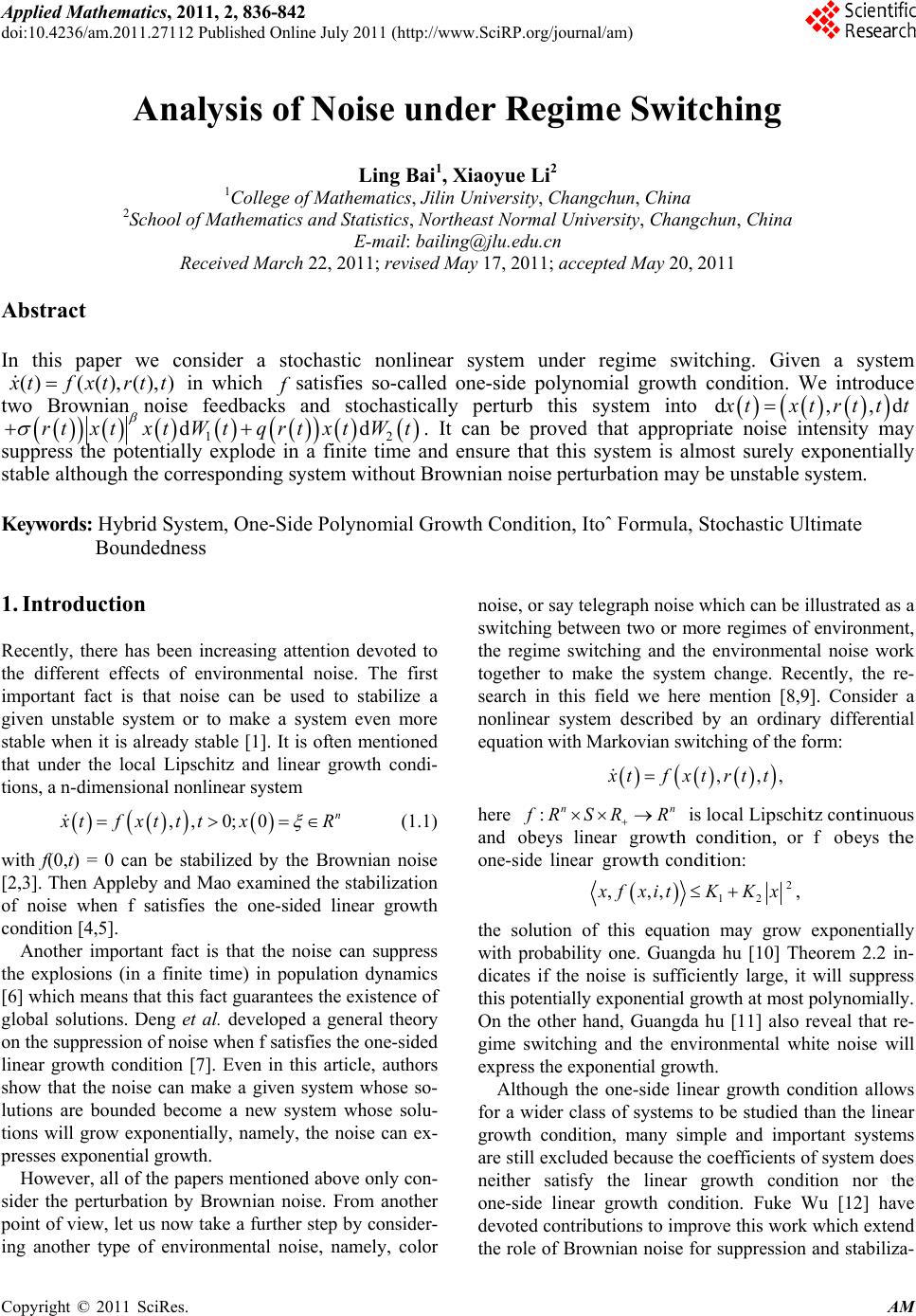 Applied Mathematics, 2011, 2, 836-842 doi:10.4236/am.2011.27112 Published Online July 2011 (http://www.SciRP.org/journal/am) Copyright © 2011 SciRes. AM Analysis of Noise under Regime Switching Ling Bai1, Xiaoyue Li2 1College of Mathematics, Jilin University, Changchun, China 2School of Mathema tics and Statistics, Northeast Normal University, Changchun, China E-mail: bailing@jlu.edu.cn Received March 22, 2011; revised May 17, 2011; accepted May 20, 2011 Abstract In this paper we consider a stochastic nonlinear system under regime switching. Given a system ()((),(),) tfxtrtt in which satisfies so-called one-side polynomial growth condition. We introduce two Brownian noise feedbacks and stochastically perturb this system into d,,d txtrttt rtxtxt Wttxt Wt 1 dqr 2 . It can be proved that appropriate noise intensity may suppress the potentially explode in a finite time and ensure that this system is almost surely exponentially stable although the corresponding system without Brownian noise perturbation may be unstable system. d Keywords: Hybrid System, One-Side Polynomial Growth Condition, Itoˆ Formula, Stochastic Ultimate Boundedness 1. Introduction Recently, there has been increasing attention devoted to the different effects of environmental noise. The first important fact is that noise can be used to stabilize a given unstable system or to make a system even more stable when it is already stable [1]. It is often mentioned that under the local Lipschitz and linear growth condi- tions, a n-dimensional nonlinear system ,,0; 0n tfxttt xR (1.1) with f(0,t) = 0 can be stabilized by the Brownian noise [2,3]. Then Appleby and Mao examined the stabilization of noise when f satisfies the one-sided linear growth condition [4,5]. Another important fact is that the noise can suppress the explosions (in a finite time) in population dynamics [6] which means that this fact guarantees the existence of global solutions. Deng et al. developed a general theory on the suppression of noise when f satisfies the one-sided linear growth condition [7]. Even in this article, authors show that the noise can make a given system whose so- lutions are bounded become a new system whose solu- tions will grow exponentially, namely, the noise can ex- presses exponential growth. However, all of the papers mentioned above only con- sider the perturbation by Brownian noise. From another point of view, let us now take a further step by consider- ing another type of environmental noise, namely, color noise, or say telegraph noise which can be illustrated as a switching between two or more regimes of environment, the regime switching and the environmental noise work together to make the system change. Recently, the re- search in this field we here mention [8,9]. Consider a nonlinear system described by an ordinary differential equation with Markovian switching of the form: ,,, tfxtrtt here :nn RSR R is local L i p s c h i t z co n t i n uous and obeys linear g r ow t h co nd i t io n, or f o b e ys the one-side linear g r ow t h co nd i t io n : 2 12 ,,, , fxitK Kx the solution of this equation may grow exponentially with probability one. Guangda hu [10] Theorem 2.2 in- dicates if the noise is sufficiently large, it will suppress this potentially exponential growth at most polynomially. On the other hand, Guangda hu [11] also reveal that re- gime switching and the environmental white noise will express the exponential growth. Although the one-side linear growth condition allows for a wider class of systems to be studied than the linear growth condition, many simple and important systems are still excluded because the coefficients of system does neither satisfy the linear growth condition nor the one-side linear growth condition. Fuke Wu [12] have devoted contributions to improve this work which extend the role of Brownian noise for suppression and stabiliza- 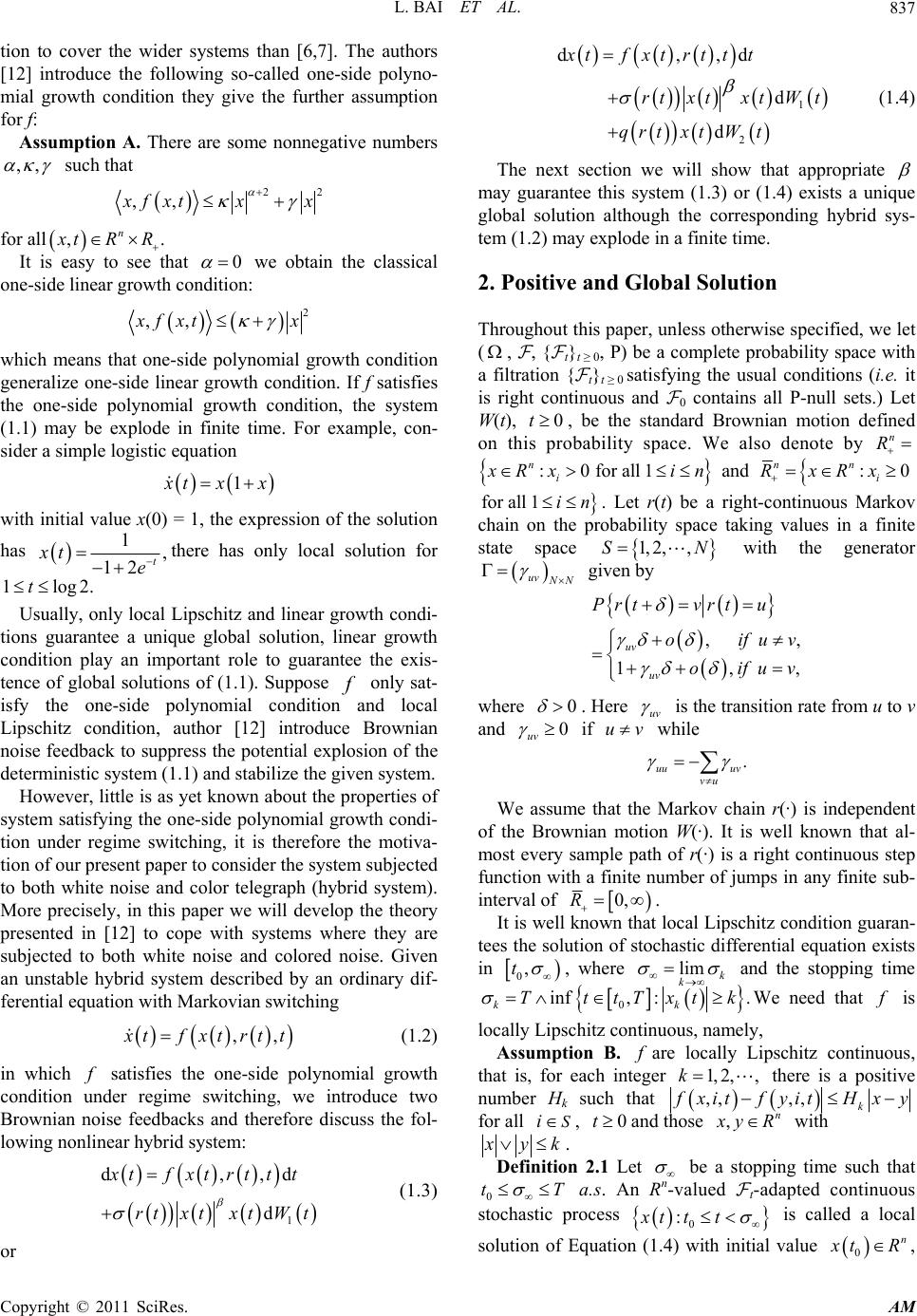 L. BAI ET AL.837 tion to cover the wider systems than [6,7]. The authors [12] introduce the following so-called one-side polyno- mial growth condition they give the further assumption for f: Assumption A. There are some nonnegative numbers ,, such that 22 ,, fxtxx for all ,. n tRR It is easy to see that 0 we obtain the classical one-side linear growth condition: 2 ,, fxtx which means that one-side polynomial growth condition generalize one-side linear growth condition. If f satisfies the one-side polynomial growth condition, the system (1.1) may be explode in finite time. For example, con- sider a simple logistic equation 1 tx x with initial value x(0) = 1, the expression of the solution has 1, 12t xt e there has only local solution for 1logt2. Usually, only local Lipschitz and linear growth condi- tions guarantee a unique global solution, linear growth condition play an important role to guarantee the exis- tence of global solutions of (1.1). Suppose only sat- isfy the one-side polynomial condition and local Lipschitz condition, author [12] introduce Brownian noise feedback to suppress the potential explosion of the deterministic system (1.1) and stabilize the given system. However, little is as yet known about the properties of system satisfying the one-side polynomial growth condi- tion under regime switching, it is therefore the motiva- tion of our present paper to consider the system subjected to both white noise and color telegraph (hybrid system). More precisely, in this paper we will develop the theory presented in [12] to cope with systems where they are subjected to both white noise and colored noise. Given an unstable hybrid system described by an ordinary dif- ferential equation with Markovian switching ,, tfxtrtt (1.2) in which satisfies the one-side polynomial growth condition under regime switching, we introduce two Brownian noise feedbacks and therefore discuss the fol- lowing nonlinear hybrid system: 1 d,, d d tfxtrttt rtxtxtW t (1.3) or 1 2 d,,d d d xtf xtrttt rtxtxtW t qrtxtW t (1.4) The next section we will show that appropriate may guarantee this system (1.3) or (1.4) exists a unique global solution although the corresponding hybrid sys- tem (1.2) may explode in a finite time. 2. Positive and Global Solution Throughout this paper, unless otherwise specified, we let ( , , {t}t ≥ 0, P) be a complete probability space with a filtration {t}t ≥ 0 satisfying the usual conditions (i.e. it is right continuous and 0 contains all P-null sets.) Let W(t), , be the standard Brownian motion defined on this probability space. We also denote by 0tn R :0 for all 1 i n Rx in and :0 nn i Rx Rx for all 1in . Let r(t) be a right-continuous Markov chain on the probability space taking values in a finite state space 1, 2,,SN with the generator uv N given by , , 1, uv uv Prtvrt u oifu oifuv , v where 0 . Here uv is the transition rate from u to v and 0 uv if uv while . uu uv vu We assume that the Markov chain r(·) is independent of the Brownian motion W(·). It is well known that al- most every sample path of r(·) is a right continuous step function with a finite number of jumps in any finite sub- interval of 0,R . It is well known that local Lipschitz condition guaran- tees the solution of stochastic differential equation exists in 0,t , where lim k k and the stopping time 0 inf , . kk Tt k :tTxtWe need that is locally Lipschitz continuous, namely, Assumption B. are locally Lipschitz continuous, that is, for each integer there is a positive number Hk such that f 1, 2,,k ,,,, k xitfyitH xy for all Si , and those 0t,n yR with yk . Definition 2.1 Let be a stopping time such that 0 tT a.s. An Rn-valued t-adapted continuous stochastic process 0 :xt tt is called a local solution of Equation (1.4) with initial value 0 n tR, Copyright © 2011 SciRes. AM 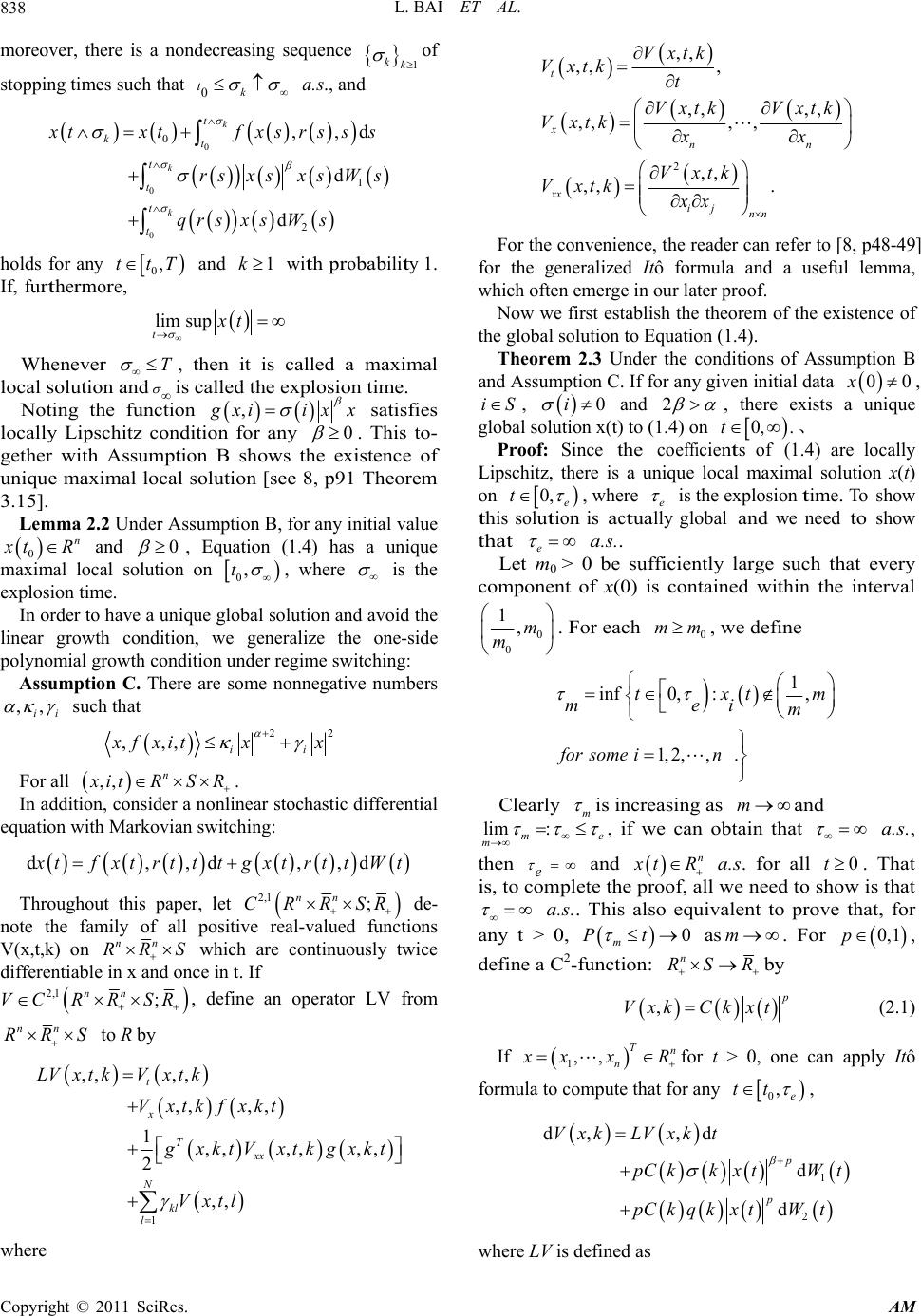 L. BAI ET AL. 838 moreover, there is a nondecreasing sequence 1 kk of stopping times such that 0k t a.s., and 0 0 0 0 1 2 ,,d d d k k k t kt t t t t txtfxsrss rsxsxsWs qrsxsWs s holds for any and wi t h p r o b a b ili t y 1. If, f u r t h e r m o r e , 0,ttT1k lim sup txt Whenever T , then it is called a maximal local solution and is called the explosion time. Noting the function , xii xx satisfies locally Lipschitz condition for any 0 . This to- gether with Assumption B shows the existence of unique maximal local solution [see 8, p91 Theorem 3.15]. Lemma 2.2 Under Assumption B, for any initial value 0 n tR and 0 , Equation (1.4) has a unique maximal local solution on 0,t , where is the explosion time. In order to have a unique global solution and avoid the linear growth condition, we generalize the one-side polynomial growth condition under regime switching: Assumption C. There are some nonnegative numbers ,, ii such that 22 ,,, ii fxit xx For all ,, n itRS R . In addition, consider a nonlinear stochastic differential equation with Markovian switching: d,,d,,d tfxtrtttgxtrttWt Throughout this paper, let 2,1; nn CRRSR de- note the family of all positive real-valued functions V(x,t,k) on nn RRS which are continuously twice differentiable in x and once in t. If 2,1; nn VCR R SR , define an operator LV from nn RRS to R by 1 ,, ,, ,,, , 1,,,, ,, 2 ,, t x Txx N kl l LV xtkVxtk Vxtkfxkt xktVxtk g xkt Vxtl where 2 ,, ,, , ,, ,, ,,, , ,, ,, . t xnn xx ij nn Vxtk Vxtk t Vxtk Vxtk Vxtk xx Vxtk Vxtk xx For the convenience, the reader can refer to [8, p48-49] for the generalized Itô formula and a useful lemma, which often emerge in our later proof. Now we first establish the theorem of the existence of the global solution to Equation (1.4). Theorem 2.3 Under the conditions of Assumption B and Assumption C. If for any given initial data 00x , iS , 0i and 2 t, there exists a unique global solution x(t) to (1.4) on 、 0, . Proof: Since the coe ffi cie n t s of (1.4) are locally Lipschitz, there is a unique local maximal solution x(t) on 0, e t , where e is the explosion t i m e . To show t h i s s ol u t io n is a c t u a ll y global a nd we need to show that e a . s . . Let m 0 > 0 be sufficiently large such that every component of x (0) is contained within the interval 0 0 1,m m . For each , we define 0 mm 1 inf0, :, 1,2,,. txt mei m forsome in m Clearly m is increasing as and m lim : m me , if we can obtain that a.s. , then e and n tR a.s . for all . That is, to complete the proof, all we need to show is that 0t a.s. . This also equivalent to prove that, for any t > 0, 0 m Pt as . For m 0, 1p , define a C 2 -function: n RS R by , VxkCkxt (2.1) If 1,, Tn n xxR for t > 0, one can apply Itô formula to compute that for any 0,e tt , 1 2 d, ,d d d p p VxkLVxkt pCkkx tWt pCk qkx tWt where LV is defined as Copyright © 2011 SciRes. AM 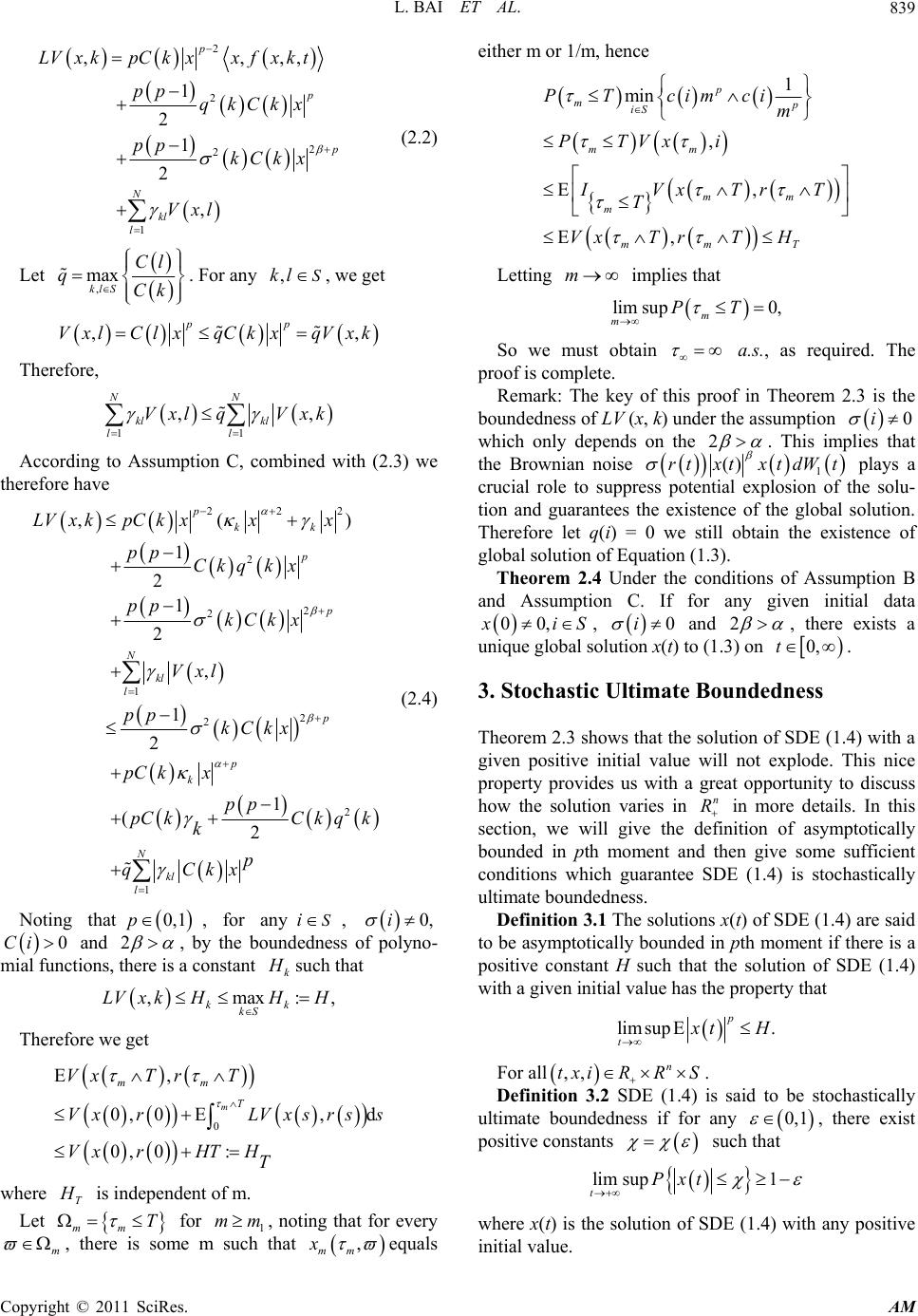 L. BAI ET AL.839 2 2 2 2 1 ,, 1 2 1 2 , p p ,, N kl l LVxkpC kxx fxkt pp qkCkx pp kCk x Vxl (2.2) Let , max kl S Cl qCk . For ,klany , we get S ,, pp V xlClxqCkxqV xk Therefore, 11 ,, NN kl kl ll Vxl qVxk According to Assumption C, combined with (2.3) we therefore have 222 2 2 2 1 2 2 2 1 ,( 1 2 1 2 , 1 2 1 (2 p kk p p N kl l p p k N kl l LVx kpCkxxx pp Ckqk x pp kCk x Vxl pp kCkx pC kx pp pC kC k qk k p qCkx ) (2.4) Noting that, for any, 0, 1pSi 0,i and 0Ci2 , by the boundedness of polyno- mial functions, there is a constant k such that ,max: kk kS LVx kHHH , Therefore we get 0 , 0, 0,d 0, 0: m mm T VxTrT VxrLVxs rss VxrHT H T where T is independent of m. Let mm for 1, noting that for every T m mm , there is some m such that , mm x equals either m or 1/m, hence 1 min , , , p mp iS mm mm m mm T PT cimci m PTVxi IVxTrT T VxTrTH Letting implies that m lim sup0, m mPT So we must obtain a.s., as required. The proof is complete. Remark: The key of this proof in Theorem 2.3 is the boundedness of LV (x, k) under the assumption 0i which only depends on the 2 . This implies that the Brownian noise ()rtxtxtdW t 1 plays a crucial role to suppress potential explosion of the solu- tion and guarantees the existence of the global solution. Therefore let q(i) = 0 we still obtain the existence of global solution of Equation (1.3). Theorem 2.4 Under the conditions of Assumption B and Assumption C. If for any given initial data 00, iS , 0i and 2 t, there exists a unique global solution x(t) to (1.3) on . 0, 3. Stochastic Ultimate Boundedness Theorem 2.3 shows that the solution of SDE (1.4) with a given positive initial value will not explode. This nice property provides us with a great opportunity to discuss how the solution varies in in more details. In this section, we will give the definition of asymptotically bounded in pth moment and then give some sufficient conditions which guarantee SDE (1.4) is stochastically ultimate boundedness. n R Definition 3.1 The solutions x(t) of SDE (1.4) are said to be asymptotically bounded in pth moment if there is a positive constant H such that the solution of SDE (1.4) with a given initial value has the property that lim sup. p t tH For all ,, n txiRRS . Definition 3.2 SDE (1.4) is said to be stochastically ultimate boundedness if for any , there exist positive constants 0, 1 such that lim sup1 tPxt where x(t) is the solution of SDE (1.4) with any positive initial value. Copyright © 2011 SciRes. AM 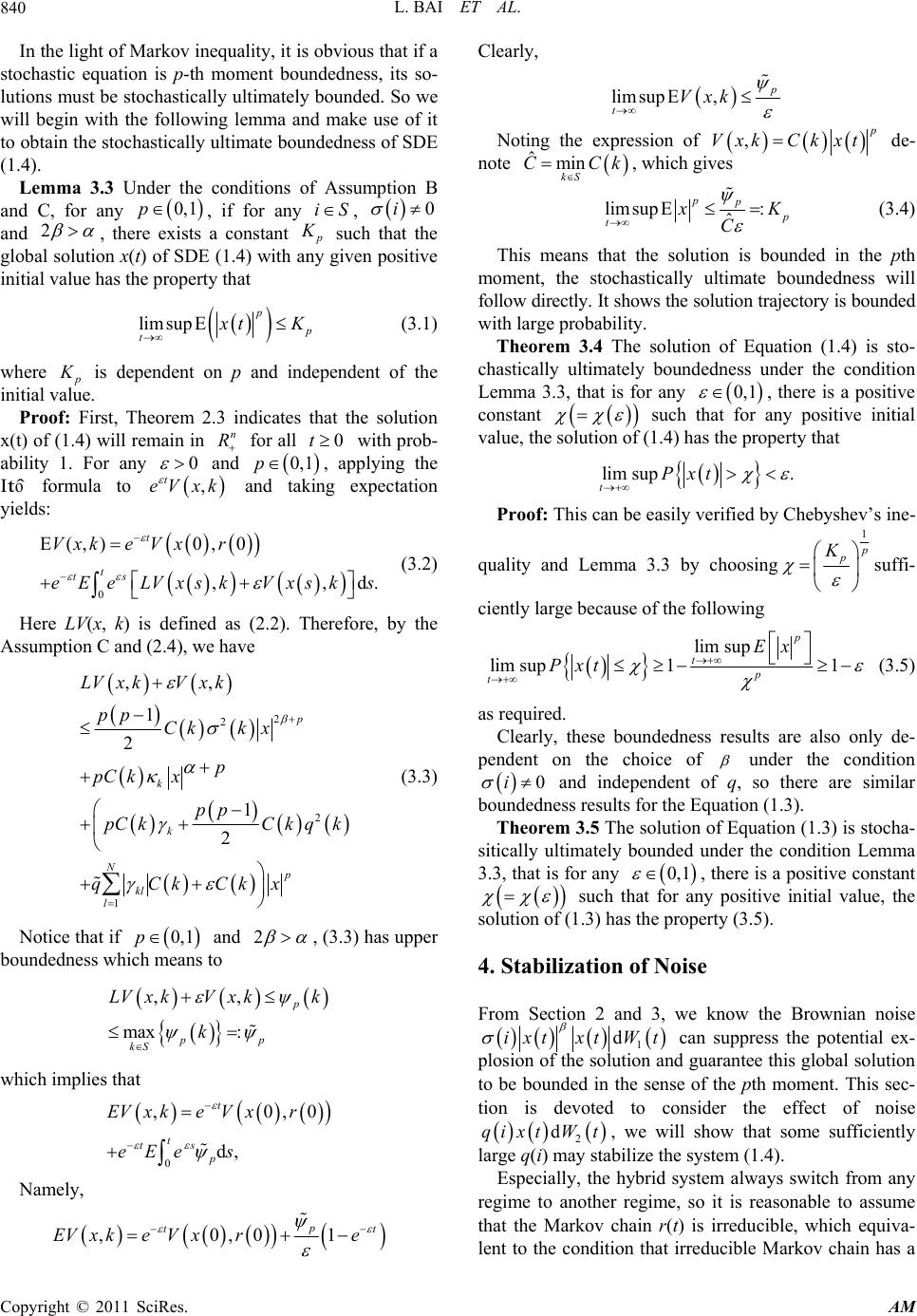 L. BAI ET AL. 840 In the light of Markov inequality, it is obvious that if a stochastic equation is p-th moment boundedness, its so- lutions must be stochastically ultimately bounded. So we will begin with the following lemma and make use of it to obtain the stochastically ultimate boundedness of SDE (1.4). Lemma 3.3 Under the conditions of Assumption B and C, for any , if for any , 0, 1piS 0i and 2 , there exists a constant such that the global solution x(t) of SDE (1.4) with any given positive initial value has the property that lim supp t t K (3.1) where is dependent on p and independent of the initial value. Proof: First, Theorem 2.3 indicates that the solution x(t) of (1.4) will remain in n R for all with prob- ability 1. For any 0t 0 , t eV x and , applying the I t o ˆ formula to and taking expectation yields: 0,p 1 k 0 (, )0,0 ,, t t ts Vxke Vxr eEe LVxskVxsks d. (3.2) Here LV(x, k) is defined as (2.2). Therefore, by the Assumption C and (2.4), we have 2 2 2 1 ,, 1 2 1 2 p k k Np kl l LVx kVx k pp Ckk x p pC kx pp pC kC k qk qCkCkx (3.3) Notice that if and 0, 1p2 , (3.3) has upper boundedness which means to ,, max : p pp kS LVx kVx kk k which implies that 0 ,0, d, t t ts p EVx keVxr eEe s 0 Namely, ,0,01 p tt EVx keVxre Clearly, lim sup, tVxk Noting the expression of , Vxk Ckxt de- note ˆmin kS CC k, which gives lim sup: ˆ pp t K C (3.4) This means that the solution is bounded in the pth moment, the stochastically ultimate boundedness will follow directly. It shows the solution trajectory is bounded with large probability. Theorem 3.4 The solution of Equation (1.4) is sto- chastically ultimately boundedness under the condition Lemma 3.3, that is for any , there is a positive constant 0,1 such that for any positive initial value, the solution of (1.4) has the property that lim sup. tPxt Proof: This can be easily verified by Chebyshev’s ine- quality and Lemma 3.3 by choosing 1 p K suffi- ciently large because of the following lim sup lim sup11 p tp t Ex Pxt (3.5) as required. Clearly, these boundedness results are also only de- pendent on the choice of under the condition 0i and independent of q, so there are similar boundedness results for the Equation (1.3). Theorem 3.5 The solution of Equation (1.3) is stocha- sitically ultimately bounded under the condition Lemma 3.3, that is for any 0, 1 , there is a positive constant such that for any positive initial value, the solution of (1.3) has the property (3.5). 4. Stabilization of Noise From Section 2 and 3, we know the Brownian noise 1 dixtxt Wt can suppress the potential ex- plosion of the solution and guarantee this global solution to be bounded in the sense of the pth moment. This sec- tion is devoted to consider the effect of noise 2 dqixtWt , we will show that some sufficiently large q(i) may stabilize the system (1.4). Especially, the hybrid system always switch from any regime to another regime, so it is reasonable to assume that the Markov chain r(t) is irreducible, which equiva- lent to the condition that irreducible Markov chain has a Copyright © 2011 SciRes. AM 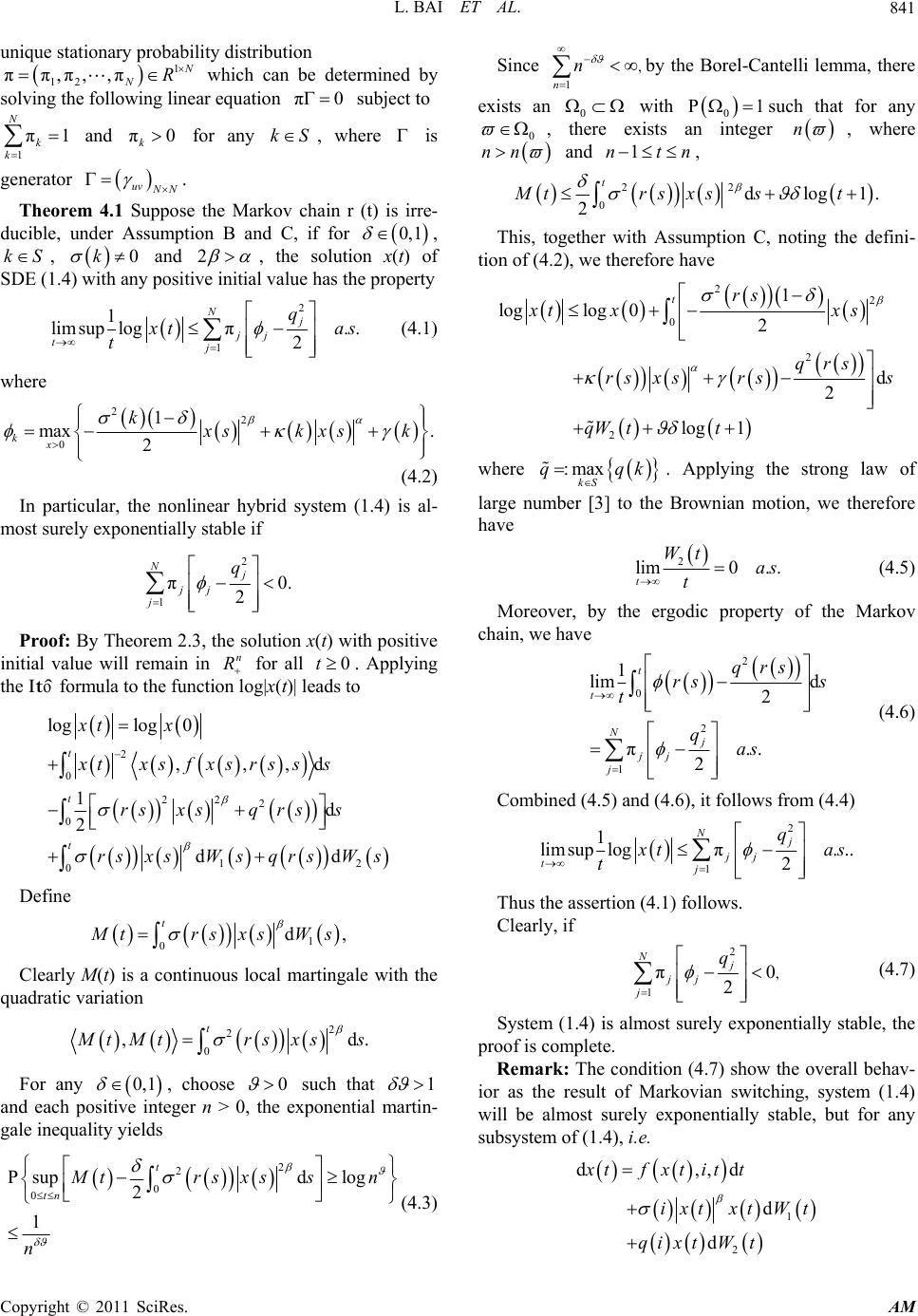 L. BAI ET AL.841 unique stationary probability distribution 1 12 ππ,π,,π NR which can be determined by solving the following linear equation subject to π0 1 π1 N k k and for any , where π0 kkS is generator uv N . Theorem 4.1 Suppose the Markov chain r (t) is irre- ducible, under Assumption B and C, if for 0,1 , , and kS 0k 2 , the solution x(t) of SDE (1.4) with any positive initial value has the property 2 1 1 lim suplogπ.. 2 Nj jj tj q ta t s (4.1) where 22 0 1 max . 2 kx k skxsk (4.2) In particular, the nonlinear hybrid system (1.4) is al- most surely exponentially stable if 2 1 π0. 2 Nj jj j q Proof: By Theorem 2.3, the solution x(t) with positive initial value will remain in n R for all . Applying the I t o ˆ formula to the function log|x(t)| leads to 0t 2 0 2 22 0 12 0 loglog 0 ,,,d 1d 2 dd t t t xt x xtxsf xsrsss rsxsq rss rsxsW sqrsWs Define 1 0d, t trsxsW s Clearly M(t) is a continuous local martingale with the quadratic variation 2 2 0 ,d t. tMtrs xss For any , choose 0,1 0 such that 1 and each positive integer n > 0, the exponential martin- gale inequality yields 2 2 0 0 supd log 2 1 t tn trsxss n Since 1 , n n by the Borel-Cantelli lemma, there exists an 0 with 01 such that for any 0 , there exists an integer n , where nn and 1ntn , 22 0dlog1. 2 t Mtrsxsst n (4.3) This, together with Assumption C, noting the defini- tion of (4.2), we therefore have 2 2 0 2 2 1 loglog 02 d 2 log 1 trs xt xxs qrs rs xsrss qW tt where :max kS qq k. Applying the strong law of large number [3] to the Brownian motion, we therefore have 2 lim0. . t Wt as t (4.5) Moreover, by the ergodic property of the Markov chain, we have 2 0 2 1 1 lim d 2 π.. 2 t t Nj jj j qrs rs s t qas (4.6) Combined (4.5) and (4.6), it follows from (4.4) 2 1 1 lim suplogπ... 2 Nj jj tj q ta t s Thus the assertion (4.1) follows. Clearly, if 2 1 ,π0 2 Nj jj j q (4.7) System (1.4) is almost surely exponentially stable, the proof is complete. Remark: The condition (4.7) show the overall behav- ior as the result of Markovian switching, system (1.4) will be almost surely exponentially stable, but for any subsystem of (1.4), i.e. 1 2 d,,d d d xtf xtitt ixtxt Wt qixtW t Copyright © 2011 SciRes. AM 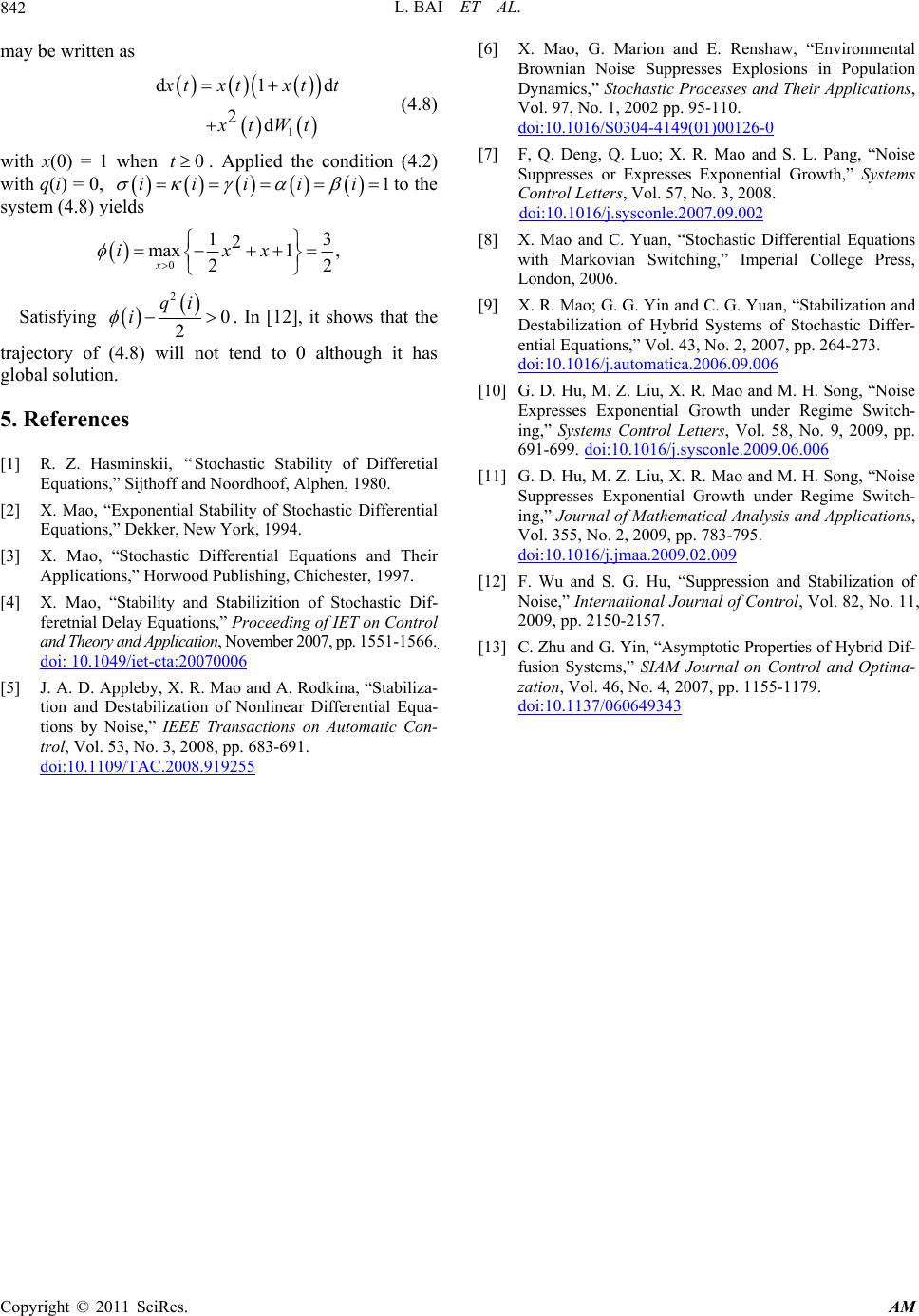 L. BAI ET AL. Copyright © 2011 SciRes. AM 842 [6] X. Mao, G. Marion and E. Renshaw, “Environmental Brownian Noise Suppresses Explosions in Population Dynamics,” Stochastic Processes and Their Applications, Vol. 97, No. 1, 2002 pp. 95-110. doi:10.1016/S0304-4149(01)00126-0 may be written as 1 d1 2d d txt xt xtWt t (4.8) [7] F, Q. Deng, Q. Luo; X. R. Mao and S. L. Pang, “Noise Suppresses or Expresses Exponential Growth,” Systems Control Letters, Vol. 57, No. 3, 2008. doi:10.1016/j.sysconle.2007.09.002 with x(0) = 1 when . Applied the condition (4.2) with q(i) = 0, 0t 1iii ii to the system (4.8) yields 0 13 2 max1 , 22 x ixx [8] X. Mao and C. Yuan, “Stochastic Differential Equations with Markovian Switching,” Imperial College Press, London, 2006. Satisfying 2 0 2 qi i . In [12], it shows that the trajectory of (4.8) will not tend to 0 although it has global solution. [9] X. R. Mao; G. G. Yin and C. G. Yuan, “Stabilization and Destabilization of Hybrid Systems of Stochastic Differ- ential Equations,” Vol. 43, No. 2, 2007, pp. 264-273. doi:10.1016/j.automatica.2006.09.006 [10] G. D. Hu, M. Z. Liu, X. R. Mao and M. H. Song, “Noise Expresses Exponential Growth under Regime Switch- ing,” Systems Control Letters, Vol. 58, No. 9, 2009, pp. 691-699. doi:10.1016/j.sysconle.2009.06.006 5. References [1] R. Z. Hasminskii, “Stochastic Stability of Differetial Equations,” Sijthoff and Noordhoof, Alphen, 1980. [11] G. D. Hu, M. Z. Liu, X. R. Mao and M. H. Song, “Noise Suppresses Exponential Growth under Regime Switch- ing,” Journal of Mathematical Analysis and Applications, Vol. 355, No. 2, 2009, pp. 783-795. doi:10.1016/j.jmaa.2009.02.009 [2] X. Mao, “Exponential Stability of Stochastic Differential Equations,” Dekker, New York, 1994. [3] X. Mao, “Stochastic Differential Equations and Their Applications,” Horwood Publishing, Chichester, 1997. [12] F. Wu and S. G. Hu, “Suppression and Stabilization of Noise,” International Journal of Control, Vol. 82, No. 11, 2009, pp. 2150-2157. [4] X. Mao, “Stability and Stabilizition of Stochastic Dif- feretnial Delay Equations,” Proceeding of IET on Control and Theory and Application, November 2007, pp. 1551-1566. doi: 10.1049/iet-cta:20070006 [13] C. Zhu and G. Yin, “Asymptotic Properties of Hybrid Dif- fusion Systems,” SIAM Journal on Control and Optima- zation, Vol. 46, No. 4, 2007, pp. 1155-1179. doi:10.1137/060649343 [5] J. A. D. Appleby, X. R. Mao and A. Rodkina, “Stabiliza- tion and Destabilization of Nonlinear Differential Equa- tions by Noise,” IEEE Transactions on Automatic Con- trol, Vol. 53, No. 3, 2008, pp. 683-691. doi:10.1109/TAC.2008.919255
|